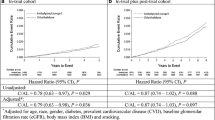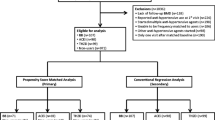Abstract
Summary
Greater bone mineral density was observed after treating hypertension using angiotensin-converting enzyme inhibitor (ACEi). We report decreased rate of bone loss in hypertensive black men using ACEi for 9 years. There may be a gender- and race-specific effect of ACEi in the prevention of age-associated bone loss.
Purpose
There is evidence of bone mass preservation in patients receiving ACEis, commonly used to treat hypertension. However, limitations of previous studies include being cross-sectional or only including a short-term follow-up of patients using ACEi and including patients with diabetes, which affects bone metabolism. None of the previous studies described effects of ACEi stratified by race. The objective of this study was to investigate differences in changes in bone mineral density (BMD) in older adults who suffer from hypertension and had reported ACEi use during each study visit for at least 9 years during the study, stratified by gender and race.
Methods
We used data from the Dynamics of Health, Aging and Body Composition (HABC) study, which enrolled 3075 community-dwelling older white and black individuals. We compared changes in femoral neck, total hip, and whole-body BMD after either no use of ACEi (n = 580) or long-term use (at least 9 years) of ACEi (n = 239) in HABC participants with hypertension and no known diagnosis of diabetes mellitus.
Results
Overall, BMD values significantly decreased for all subgroups over time. In the stratified multivariate analysis, long-term use of ACEi was associated with a reduced rate of decline for all three BMD measures among black men, but no significant effect was observed in the other subgroups.
Conclusion
Our findings show a gender- and race-specific effect of ACEi in the prevention of age-associated bone loss that warrants further evaluation.


Similar content being viewed by others
References
National Osteoporosis Foundation (NOF). www.nof.org. Accessed on 25 Jan 2017
Kling JM, Clarke BL, Sandhu NP (2014) Osteoporosis prevention, screening, and treatment: a review. J Women's Health (Larchmt) 23(7):563–572
Reginster JY, Neuprez A, Dardenne N et al (2014) Efficacy and safety of currently marketed anti-osteoporosis medications. Best Pract Res Clin Endocrinol Metabol 28(6):809–834
Silverman S, therapy CCI o (2012) Osteoporos Int 23(3):797–809
Cappuccio F, Meilahn E, Zmuda JM, Cauley JA, for the Study of Osteoporotic Fractures Research Group (1999) High blood pressure and bone-mineral loss in elderly white women: a prospective study. Lancet 354:971–975
Tsuda K, Nishio I, Masuyama Y (2001) Bone mineral density in women with essential hypertension. Am J Hypertens 14:704–707
Vestergaard P, Rejnmark L, Mosekilde L (2009) Hypertension is a risk factor for fractures. Calcif Tissue Int 84:103–111
Hatton R, Stimpel M, Chambers TJ (1997) Angiotensin II is generated from angiotensin I by bone cells and stimulates osteoclastic bone resorption in vitro. J Endocrinol 152(1):5–10
Shimizu H, Nakagami H, Osako MK et al (2008) Angiotensin II accelerates osteoporosis by activating osteoclasts. FASEB J 22:2465–2475
Hagiwara H, Hiruma Y, Inoue A et al (1998) Deceleration by angiotensin II of the differentiation and bone formation of rat calvarial osteoblastic cells. J Endocrinol 156:543–550
Lamparter S, Kling L, Schrader M et al (1998) Effects of angiotensin II on bone cells in vitro. J Cell Physiol 175:89–98
SS G, Zhang Y, Li XL et al (2012) Involvement of the skeletal renin-angiotensin system in age-related osteoporosis of ageing mice. Biosci Biotechnol Biochem 76:1367–1371
Asaba Y, Ito M, Fumoto T et al (2009) Activation of renin-angiotensin system induces osteoporosis independently of hypertension. J Bone Miner Res 24(2):241–250
Izu Y, Mizoguchi F, Kawamata A et al (2008) Angiotensin II type 2 receptor blockade increases bone mass. J Biol Chem 284(8):4857–4864
Rejnmark L, Vestergaard P, Mosekilde L (2006) Treatment with beta-blockers, ACE inhibitors, and calcium-channel blockers is associated with a reduced fracture risk: a nationwide case–control study. J Hypertens 24(3):581–589
Peters R, Beckett N, Burch L et al (2010) The effect of treatment based on a diuretic (indapamide) ± ACE inhibitor (perindopril) on fractures in the hypertension in the very elderly trial (HYVET). Age Ageing 39(5):609–616
Lynn H, Kwok T, Wong SYS et al (2006) Angiotensin converting enzyme inhibitor use is associated with higher bone mineral density in elderly Chinese. Bone 38:584–588
Rianon N, Garcia M, Stotts A et al (2011) Associations between femur neck BMD and antihypertensive medications affecting renin-angiotensin system in elderly men and women of the Health ABC study. Presented at the Forum on Aging and Skeletal Health. Bethesda, MD
Perez-Castrillon JL, Silva J, Justo I et al (2003) Effect of quinapril, quinapril-hydrochlorothiazide, and enalapril on the bone mass of hypertensive subjects: relationship with angiotensin converting enzyme polymorphisms. Am J Hypertens 16(6):453–459
National Institute on Aging. Health ABC. https://www.nia.nih.gov/research/intramural-research-program/dynamics-health-aging-and-body-composition-health-abc. Accessed on 25 Jan 2017
Looker AC, Wahner HW, Dunn WL et al (1998) Updated data on proximal femur bone mineral levels of US adults. Osteoporos Int 8:468–489
Solomon D, Ruppert K, Zhao Z et al (2016) Bone mineral density changes among women initiating blood pressure lowering drugs: a SWAN cohort study. Osteoporos Int 27:1181–1189
Kwok T, Leung J, Zhang YF et al (2012) Does the use of ACE inhibitors or angiotensin receptor blockers affect bone loss in older men? Osteoporos Int 23:2159–2167
Zhang YF, Qin L, Leung PC et al (2012) The effect of angiotensin-converting enzyme inhibitor use on bone loss in elderly Chinese. J Bone Miner Metab 30(6):666–673
Masunari N, Fujiwara S, Nakata Y et al (2008) Effect of angiotensin-converting enzyme inhibitor and benzodiazepine intake on bone loss in older Japanese. Hiroshima J Med Sci 57:17–25
Cakmak B, Inanir A, Karakus N et al (2015) Association between the ACE gene I/D polymorphism and osteoporosis in a Turkish population. Z Rheumatol 74:346–350
Allam M, Hussien N (2016) A comparative study between the effect of 17-βestradiol and angiotensin converting enzyme inhibitor on osteoporosis in ovariectomized rats. Gen Physiol Biophys 35:433–441
Jamerson K (2000) Rationale for angiotensin II receptor blockers in patients with low-renin hypertension. Am J Kidney Dis 36:S24–S30
Acknowledgements
The authors received writing support from Patricia Fonseca, a freelance medical writer. The authors would like to acknowledge help from Sara Zwart for preparing figures. Susan Rubin, Steve Kritchevsky, Anne Newmen, Suzanne Satterfield, Diane Ives, Evan Tylavsky, and Jane Cauley contributed to data acquisition.
Author information
Authors and Affiliations
Contributions
All authors approved the final version submitted and are accountable for the accuracy and the integrity of the data presented.
Corresponding author
Ethics declarations
Conflicts of interest
None.
Rights and permissions
About this article
Cite this article
Rianon, N., Ambrose, C.G., Pervin, H. et al. Long-term use of angiotensin-converting enzyme inhibitors protects against bone loss in African-American elderly men. Arch Osteoporos 12, 94 (2017). https://doi.org/10.1007/s11657-017-0387-3
Received:
Accepted:
Published:
DOI: https://doi.org/10.1007/s11657-017-0387-3




